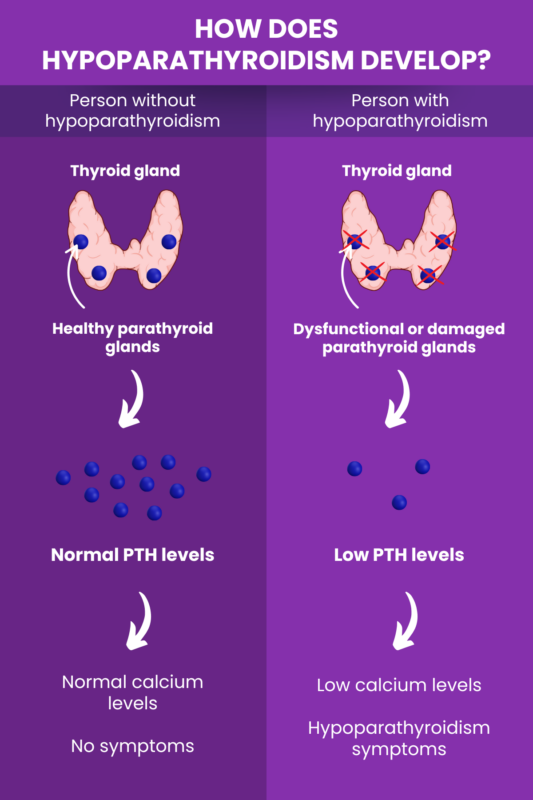Hypoparathyroidism overview
Last updated June 3, 2025, by Marisa Wexler, MS

Hypoparathyroidism is a rare disorder characterized by low levels of a hormone that helps regulate calcium and phosphorus in the body, leading to imbalances in these minerals.
People with hypoparathyroidism can experience a range of symptoms, including muscle cramps and spasms, neurological complications, and kidney problems, some of which may be life-threatening.
Although the condition often requires lifelong care, the prognosis is generally good if patients are diagnosed early and receive appropriate hypoparathyroidism treatment.
What is hypoparathyroidism?
Hypoparathyroidism is defined by reduced levels of parathyroid hormone, known as PTH. This hormone is produced by the parathyroid glands, which are small glands located in the neck near the thyroid.
When the parathyroid glands produce too little PTH, calcium levels become abnormally low and phosphorus levels rise. This calcium deficiency is responsible for most signs of hypoparathyroidism, so treatment usually aims to normalize calcium levels.
Causes of hypoparathyroidism
There are several types of hypoparathyroidism. All share the hallmark feature of low PTH levels, but the underlying hypoparathyroidism causes leading to insufficient levels of this hormone vary widely between types.
- Acquired hypoparathyroidism, the most common type, is caused by damage to the parathyroid glands, which most often arises as a complication of neck surgery.
- Autoimmune hypoparathyroidism develops due to the immune system attacking the parathyroid glands, which may be part of a broader condition or can occur as an isolated disorder.
- Congenital hypoparathyroidism is a form of the disease that’s present from birth, and is due to abnormal parathyroid development or genetic mutations that also affect other parts of the body.
- Familial isolated hypoparathyroidism occurs due to certain genetic mutations that mostly affect PTH production and secretion without causing other associated health conditions.
- Idiopathic hypoparathyroidism refers to cases in which an underlying cause cannot be determined.
Hypoparathyroidism may sometimes also be classified as either primary or secondary. Some sources suggest that primary hypoparathyroidism results from defects within the parathyroid glands, mainly due to genetic causes, while secondary hypoparathyroidism derives from other causes that disrupt the function of those glands. However, definitions vary across studies and there’s no clear consensus on how specific types should be classified.

Symptoms of hypoparathyroidism
Hypoparathyroidism can affect many different organs and tissues in the body, with most complications arising due to low levels of calcium — a mineral involved in bone and teeth formation, as well as muscle contraction, blood clotting, and normal heart function, among other functions. Common hypoparathyroidism symptoms are:
- neuromuscular problems, such as muscle spasms, muscle cramps, or unusual sensations like prickling or pins-and-needles
- neurological symptoms, such as brain fog, mental health problems, and seizures
- kidney stones and decreased kidney function
- increased bone density
- abdominal pain
- fatigue and general weakness.
Although it’s less common, hypoparathyroidism can also cause other symptoms such as abnormal heart rhythms, skin problems such as dry or scaly skin, and cataracts, which is the clouding of the lens in the eye. The disease also can cause dental issues and stunted growth in children.
Because all forms of hypoparathyroidism are marked by low PTH, symptoms are generally similar across types. Still, symptom presentation and severity can vary widely from person to person.
Diagnosis
Hypoparathyroidism is generally diagnosed via blood tests to measure PTH and calcium levels. If levels of both PTH and calcium are low, a hypoparathyroidism diagnosis can be confirmed.
These lab tests normally follow a physical examination, in which doctors check for characteristic hypoparathyroidism symptoms, and a review of a person’s medical and family history.
Urine tests to check calcium levels and kidney function may help support a hypoparathyroidism diagnosis. Then, to monitor the disease, imaging tests, assessments of bone density, and electrocardiograms to track how the heart is beating, may be used.
In some instances, genetic tests or other additional assessments may be needed to determine a person’s specific type of hypoparathyroidism. The presence of known risk factors for hypoparathyroidism, such as a history of recent neck surgery or having certain autoimmune diseases, may also help confirm the specific disease type.
Hypoparathyroidism treatment
Because most health problems associated with hypoparathyroidism are caused by low calcium levels, the main goal of hypoparathyroidism treatment is to normalize calcium levels. This is usually done by taking supplements of calcium as well as vitamin D, which helps the body absorb calcium.
If supplements aren’t sufficient, or if patients have difficulties taking them as directed, people with hypoparathyroidism may be treated with PTH replacement therapy. This involves a type of hypoparathyroidism medication that delivers a lab-made version of the defective hormone to raise PTH levels in circulation. Other medications may also sometimes be used to restore levels of calcium or other nutrients that are affected by PTH.
In addition to medication, diet is another important aspect of hypoparathyroidism management. A hypoparathyroidism diet generally aims to increase calcium intake from foods to more naturally raise calcium levels and reduce the use of supplements. In addition, it’s usually recommended that patients limit the intake of foods that are high in phosphorus such as meat, eggs, and soda.
While most hypoparathyroidism complications can be managed with appropriate treatment, some issues, such as calcium deposits in the brain and dental issues, cannot be reversed. As such, early and appropriate treatment is key to preventing serious long-term complications related to hypoparathyroidism.
Life expectancy
If hypoparathyroidism is left untreated, it can lead to serious complications such as seizures and kidney disease. But if diagnosed and treated early, the hypoparathyroidism prognosis is generally good.
While there is no hypoparathyroidism cure, life expectancy for people with the condition is typically similar to that of the general population. Despite the need for lifelong treatment, many people with chronic, long-lasting hypoparathyroidism can also experience a good quality of life.
Hypoparathyroidism News is strictly a news and information website about the disease. It does not provide medical advice, diagnosis, or treatment. This content is not intended to be a substitute for professional medical advice, diagnosis, or treatment. Always seek the advice of your physician or other qualified health provider with any questions you may have regarding a medical condition. Never disregard professional medical advice or delay in seeking it because of something you have read on this website.
Recent Posts
- Hypopara’s unpredictability causes surprises during treatment
- Online tool predicts who’s at risk for chronic complication after surgery
- Reflecting on my experience in a clinical trial during the pandemic
- With hypopara, curiosity about worsening symptoms is crucial
- I feel grateful to be surrounded by love on Thanksgiving
Related articles
-
December 5, 2025 by Heather Novak
Hypopara’s unpredictability causes surprises during treatment
-
December 3, 2025 by Bari Vapnek
Reflecting on my experience in a clinical trial during the pandemic
-
November 28, 2025 by Heather Novak
With hypopara, curiosity about worsening symptoms is crucial
-
November 26, 2025 by Bari Vapnek
I feel grateful to be surrounded by love on Thanksgiving
-
November 21, 2025 by Heather Novak
As I turn 41 with hypopara, I’m eager for what the future holds



